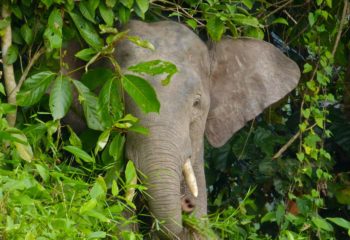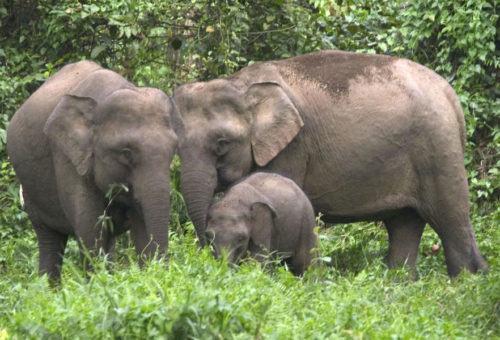View orangutan and pygmy elephants in their natural habitat
 The lower Kinabatangan floodplains are abundant in wildlife, such as Orangutan, Pygmy elephants and Sun bears. You can spend time not just admiring this amazing landscape, but helping to protect it.
The lower Kinabatangan floodplains are abundant in wildlife, such as Orangutan, Pygmy elephants and Sun bears. You can spend time not just admiring this amazing landscape, but helping to protect it.
First, you will help in conducting wildlife population surveys. You will observe these endangered species in their natural environment. Moreover, learn about their life cycles and their interconnected biodiversity roles.
Borneo wild habitat restoration to connect forest canopy
Second, get ready to do some hands on work. Plant tree saplings in the jungle. Or do a spot of ‘weeding’ to maintain the young trees that have been planted by previous volunteers. This project is part of a wider regional initiative for Borneo wild habitat restoration. It is very rewarding to witness the results of this long-term effort all around.
Additionally, you will get immersed in the local community, the gentle ‘People of the River’ (Orang Sungai in Malay): visiting them in their homes or buying and planting saplings from their nurseries. As a volunteer, you also contribute to environmental education for the school children in the village. You will gain a greater understanding about truly responsible tourism. So, make a personal impact at this Borneo wild habitat restoration project. Maybe push your own limits in the tropical rainforest landscape!
VOLUNTEER ACTIVITIES:
♥ WILDLIFE OBSERVATION
♥ MONKEYS, ORANGUTAN, ELEPHANTS
♥ HABITAT RESTORATION
♥ COMMUNITY ENGAGEMENT
Trips of 3 to 7 daysfrom RM 1,600 (group)
INCLUDES ACCOMMODATION, MEALS AND ALL ACTIVITIES
EXPERT JUNGLE GUIDE
MINIMUM AGE: 18 and over
MINIMUM NUMBER: ONE
Project activities
Wildlife Population Observation
You will spend time observing and recording local wildlife on a boat cruising along the main river and its tributaries within the wildlife sanctuary. The data you help collect will be used for the project’s population density surveys.
Habitat Restoration
This work involves tree-planting and maintenance activities at high priority areas. It involves generating saplings in the nursery and then planting, mulching, clearing invasive species and collecting data on tree growth. This is the most crucial activity in connecting fragmented forest in the area to encourage healthy orangutan and pygmy elephant populations.
Education Project & Community Development
Community and Education programmes involve interaction with the villagers and the students of the village school to promote conservation.
Jungle Trekking
As an introduction to the flora and fauna of the rainforest, you will learn about the various aspects of the rainforest habitat and its resources for the inhabitants in terms of shelter, food and medicine.
Cultural Interaction & Community Impact
Contributing back to the community is a big part of this project. In order to give back to the community, most daily meals will be hosted in the private homes of individual villagers, which will not only provide them with some income, but it will also give you an insight into their lives and culture based around the river and the rainforest.
HOW TO BOOK

AGE LIMITS:
This project is suitable for individuals, couples, families (children from age 8 ) and small groups
For special quotes , enquire here

2024 DATES & GROUPS
AVAILABLE ALL YEAR: Short trips (3-5 days) for small groups (2 to 6 people)
21 APRIL, 21 MAY, 21 SEPTEMBER, 21 OCTOBER: VOLUNTEERING for 7 days ( for individuals*)
*ask us here for group or families
PRICES - 3 DAYS/ 2 NIGHTS
Group size: 6 people
Group size: 4 people
PRICES - 7 DAYS
Individuals
Includes:
- Accommodation & Food
- All project activities
- Conservation contribution to the project
- Airport transfers
- Boat and river transfers
- Sepilok entrance fees
- English-speaking guide and project coordinator
Excludes:
- Flight fares
- Travel insurance
- Visa and Permit applications (Camera fees)
- Vaccinations
- Food/activities not included in the project
- Personal travel and personal incidentals
HOW TO BOOK

Accommodation and Food
Accommodation is included, as well as meals on working days. Volunteers will be sharing rooms throughout the project timeline. While in Sukau, volunteers will stay at a B&B Village style with ensuite showers and toilets. Single rooms are subject to availability.
Food is an important part of Malaysian culture, as you will soon find out! Volunteers are also welcome to venture out to some of the delicious local restaurants to try traditional Malay dishes – sampling the local delicacies is an experience not to be missed!


Tips for Volunteers
- We recommend comprehensive travel and health insurance coverage.
- Vaccinations – Please check with your medical practitioner on the required medication / vaccinations for the trip.
- Bring comfortable work clothing (lightweight long sleeve and pants for mosquito protection)
- Wear waterproof walking shoes in the forest
HOW TO BOOK

Lower Kinabatangan
The Kinabatangan River (Sungai Kinabatangan) located in Sabah, Borneo, is the second-longest river in Malaysia. Every year, during the northeast monsoon period, the river swells rapidly and overflows its banks creating a huge forested alluvial floodplain.
While the forested lands around Kinabatangan have undergone a major transformation due to excessive logging and development of monoculture plantations since the 1950s, the original lowland forests and mangrove swamps near the coast remains largely untouched. As such, Kinabatangan still provides a variety of habitat for the local wildlife to flourish.
Hence, the area contains some of Borneo and Southeast Asia’s highest concentrations of wildlife from proboscis monkeys and orangutans to pygmy elephants and Sumatran rhinoceros. Also, Kinabatangan is known for its bird species, including the storm’s stork and 8 varieties of hornbill.


The local project team
The local project team works with the local and international conservation organisations to balance the need of the people and the wildlife. Hence, the focus is on improving the lives of the local indigenous people (Orang Sungai) by offering an alternative income source through ecotourism, while educating and raising conservation awareness within the community. The project also supports the local wildlife by prioritising habitat restoration through its reforestation initiative. The results are closely monitored by measuring how the forest canopy is reconnected year by year. Over the past few years, the team has seen impressive numbers of orangutans and pygmy elephants return to the reforested area.
HOW TO BOOK




